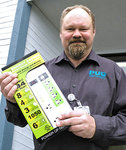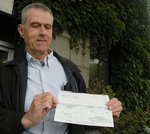Jefferson County resident Tom Thiersch received a $515 rebate check on Monday for buying a freezer and installing a heat pump. He expects to see significant savings in his electric bill this winter …
This item is available in full to subscribers.
We have recently launched a new and improved website. To continue reading, you will need to either log into your subscriber account, or purchase a new subscription.
If you had an active account on our previous website, then you have an account here. Simply reset your password to regain access to your account.
If you did not have an account on our previous website, but are a current print subscriber, click here to set up your website account.
Otherwise, click here to view your options for subscribing.
* Having trouble? Call our circulation department at 360-385-2900, or email our support.
Please log in to continue |
|


Jefferson County resident Tom Thiersch received a $515 rebate check on Monday for buying a freezer and installing a heat pump. He expects to see significant savings in his electric bill this winter because of the heat pump.
It was purely by accidental that Thiersch discovered the Jefferson County Public Utility District (PUD) rebate program. A government watchdog, Thiersch attends PUD meetings and followed up when he heard the program discussed at a PUD Citizen Advisory Board meeting.
The PUD’s conservation program has been in the works for more than a year, and the PUD expects to fire up its promotion in October, right about the time when temperatures start to dip.
So far, Thiersch is one of 130 PUD customers who have taken advantage of the conservation program, which has $880,000 in funds from Bonneville Power Administration (BPA) to disperse to power customers in Jefferson County.
As of Monday, Sept. 22, the PUD had sent invoices to BPA to recoup about $132,000. It has until Sept. 30, 2015 to spend the entire $880,000 – or risk losing it.
Thiersch, and others, have expressed concern that delays in receiving the rebates and a slow rollout will discourage participation and “could well place hundreds of thousands of dollars at risk.”
“We have hundreds of PUD customers struggling to pay their power bills or being shut off, while the PUD can’t figure out how to administer big chunks of ‘free’ money. I think this is a serious problem,” Thiersch said of why he raised the issue of his refund being delayed at a PUD board meeting earlier this month.
Thiersch had applied for one rebate in June and another in July. Thiersch said he was told it would take six to eight weeks for the rebates to be processed.
HOPEFUL
Bill Graham, the PUD’s resource manager, is more confident than Thiersch. He acknowledges that starting a conservation program from scratch has not been easy.
Electric customers were used to a rebate program when Puget Sound Energy (PSE) owned the power grid in East Jefferson County. When the PUD bought the holdings of PSE in April 2013, the PUD had to start its own program.
And that has been slowgoing.
A citizen advisory board was created last year and a subcommittee was given the task of helping the PUD decide which class of customers – residential, commercial, industrial, nonprofit, for example – should get how much money. It studied the benefits of giving money to the various categories of customers and came up with a recommendation earlier this year.
Cascadia Consultants was hired to assist in launching the program, but a Cascadia employee who had been working with the PUD left for another job in the summer, PUD officials said.
As of this week, 130 individual PUD customers have applied for 146 rebates, with the average rebate amounting to about $600, Graham said. He said most rebates are for ductless heat pumps. People can also apply for rebates for insulation and for energy-efficient appliances, including washers, refrigerators and freezers. (Forms are available online at
jeffpud.org.)
Residential energy conservation is the largest part of the overall conservation program, and the PUD expects to spend $430,000 of the $880,000 on that one category.
Another $50,000 has been set aside to do work on Mountain View Commons, property owned by the Port Townsend School District and leased by the City of Port Townsend. The property is home to the swimming pool, city police station, Port Townsend Food Bank, YMCA program, Red Cross and KPTZ-FM radio station.
And $100,000 has been set aside for industrial and federal projects, which could include projects by the U.S. Navy and the Port Townsend Paper Corp. Those dollar amounts also may change over the year, depending on what projects get going.
(The Port Townsend & Jefferson County Leader also took advantage of the available funds for commercial accounts to improve lighting in its historic building on Adams Street.)
Initially, the advisory board had suggested Olympic Community Action Programs (OlyCAP) be given $225,000.
Graham said that since then, the PUD and OlyCAP have worked out an agreement that gives OlyCAP $50,000 to do a “whole home” approach on five houses. Graham said there was concern that if the PUD gave the full $225,000 that was initially set aside for OlyCAP, it would not affect enough low-income people.
“Their program was so concentrated in terms of the amount of money and the projects to so few, we felt we had to be broader than that,” Graham said.
RESIDENTIAL PLAN
The aim of the PUD’s residential program – one arm of the overall conservation program – is to bring a small team of energy experts into a home to install as many energy-saving measures in a single day – from insulation to showerheads.
Graham said the PUD also is hoping to set up a financial resource, such as a bank, from which homeowners could obtain loans to fund larger weatherization efforts that require major outlays in cash, much as Thiersch did.
That said, the PUD also is hoping to be able to “zero out” conservation measures available to those with low incomes.
“We’re trying to make it so folks can get a number of measures installed at no expense to themselves,” Graham said of this branch of the program the PUD is developing.
“We are anticipating a surge in activity and interest in the program. We want it and we’re ready for it. It needs to happen because the money needs to be spent,” Graham said.
REBATE, OTHER DELAYS
Geoff Crump, OlyCAP executive director, acknowledged that while OlyCAP is thrilled to get the $50,000, it spent almost a year working with the PUD to get that to happen.
“If we would have been able to work with the Citizen Advisory Board and the PUD earlier, we could have doubled our production,” Crump said.
Like Thiersch, Crump has had concerns that the PUD has been slow to start its conservation program.
“If people have money and they don’t have the system, it goes to the low-hanging fruit like those governments that can easily chunk away at $100,000. If there isn’t a mechanism in place to prioritize conservation, it usually goes to a bigger player,” Crump said of his concern, one that Thiersch shares.
Low-income customers, Crump said, should be a priority so that they can save energy, which, in turn, helps keep their bills lower, which, in turn, helps them to pay the PUD on time.
FOCUS ON KILOWATTS
Graham said the underlying concern for BPA is saving energy and kilowatt hours.
“It’s better to focus on the kilowatt hours saved. A lot of people don’t care. They think it’s about the money. For our purposes and for BPA’s, it’s about the kilowatt hours saved,” Graham said.
The point of the energy conservation program, he said, is to prevent BPA from having to buy power elsewhere to meet an increase in demand – or worse, forcing the BPA to invest in expensive infrastructure to keep up with an increase in demand.
Getting more bang for your buck – saving more kilowatt hours – led Graham to question recently whether he has the authority to deviate from the Citizen Advisory Board recommendations and give either the Port Townsend Paper Corp. or the U.S. Navy more money to improve their energy conservation efforts.
“One of the issues we have is on the residential side: You slowly, incrementally improve things, whereas if you go do the mill project, you can take a megawatt off the grid in an instant,” Graham said. (A megawatt is 1,000 kilowatts.)
Parker said that he sees giving money to the larger organizations more as a fall-back position, and he is concerned about the government projects getting done in time to meet that BPA deadline next year.
Parker said he would like to see conservation money go to attacking the problem of people having high electric bills. “Then you are attacking the problem,” Parker said, “and not the symptom.”
A flier advertising the PUD’s residential rebate program should be mailed out in October.
In the meantime, Thiersch took his $515 check to the bank on Monday, delighted that his persistence and all those meetings he attended have paid off.